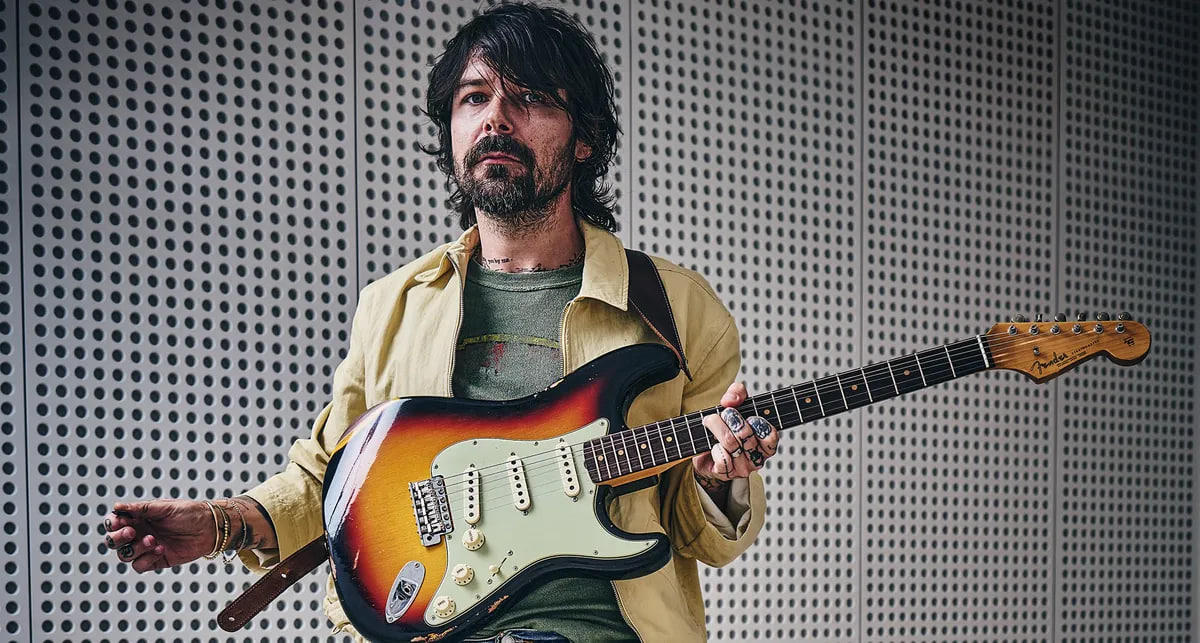Biffy Clyro’s Simon Neil on making the ground tremble with a single note
Dec. 5, 2025, 9 a.m.
“I’m scared to even look at that guitar — it costs more than a car.” Biffy Clyro’s Simon Neil on making the ground tremble with a single note, and why he fell for Kirk Hammett’s Greeny despite being a lifelong Strat loyalist
With their 10th studio album Futique, Scottish rock powerhouse Biffy Clyro once again proves why they remain one of the most influential bands of the modern era. Over nearly three decades, the trio has crafted a distinct blend of anthemic intensity and emotional nuance — a sound shaped in no small part by frontman Simon Neil’s unique approach to the guitar.
Although he is best known as a devoted Stratocaster player, Futique showcases a broader palette than ever before. Working with producer Jonathan Gilmore for the first time opened the door to new structures, additional layers, and a more experimental sonic architecture.
🎸 “The Strat is everything to me. It’s the foundation of our sound.”
Asked why he’s so deeply connected to the Strat, Neil explains:
“The Strat is everything. My favourite model is the Michael Landau Signature. I bought one about 10 years ago, and it just spoke to me — now I own two. One of them is my main studio guitar.”
But he hasn’t been afraid to explore.
He tried instruments from boutique UK builder Fairlane Guitars, played a Novo belonging to his tour manager, and even used a ’90s Fender Champ with a built-in speaker on several tracks.
“Quiet in the room, but when you mic it up — pure magic. Warm, gritty, and perfect for adding character.”

🏆 Rare guitars: from a ’63 SG to the legendary Greeny
Neil doesn’t consider himself a collector, yet he owns a few truly special pieces.
His most extravagant purchase:
“I treated myself to a Custom Shop ’59 Les Paul ‘Greeny’ reissue while in Nashville. I hesitated — it’s a huge amount of money.”
Despite being rooted in the Fender world, he felt an instant connection to the iconic instrument associated with Peter Green, Gary Moore, and now Kirk Hammett.
“I’m a massive Metallica fan. I’ve watched Kirk play that guitar for years. Les Pauls have their own power, and they’re incredibly useful in the studio — even if wearing one feels like putting on someone else’s clothes.”
His collection also includes:
- a 1977 Les Paul,
- a ’63 SG from Norm’s Rare Guitars,
- a White Falcon,
- and other classics.
The SG, though stunning, struggles to stay in tune onstage — so he mainly uses it for writing.
💿 Did Greeny appear on the album?
- Yes. “It’s on A Thousand And One, It’s Chemical! and Woe Is Me, Wow Is You. I’m nervous around it — it’s such an expensive guitar — but that out-of-phase middle position is unbelievable. Almost Strat-like.”
⚙️ Gear: Twin Reverb, JCM800, and a modern production approach
The main amps were:
- Fender Twin Reverb,
- Marshall JCM800,
- a quirky vintage Sears amp,
- and equipment from Audio Kitchen (Little Chopper, Big Trees).
For the first time, the band embraced DI tracks and post-processing, giving the album a more contemporary feel.
“I used to avoid DI completely, but it brings a unique quality. The album ended up sounding more modern — more layered.”
⚡ “Add too much, and the mix starts to shrink”
Neil explains that there’s a fine line between richness and overproduction.
“I always aim for a huge sound, but Jonathan kept us from crossing the point where the song collapses under its own weight.”
Despite the experimentation, Biffy Clyro still tests every track the same way: if it works with just a basic amp and a few pedals, it will translate in any context.
🔊 Open tunings and the power of DADGAD
The soaring single A Little Love emerged from a shift from minor to major — and from the expressive properties of DADGAD tuning.
“With one or two fingers, you can create huge emotional chords. There’s something liberating about making the earth shake with a single note.”
🧪 The Booooom Blast pedal
Neil and his tech Richard Pratt launched their own pedal — the Booooom Blast — in 2020.
“We still make them, but only in small handmade batches. I want it to remain personal, not mass-produced.”
🤘 On high-gain pedals, style, and the mystery of the guitar
Neil laughs recalling how even Eric Clapton and David Gilmour used the BOSS HM-2, a pedal now tied to extreme Scandinavian metal:
“It shows that gear can be used in completely unexpected ways. Your hands matter far more than the equipment.”
He also admits that sometimes he needs to return to a “beginner” mindset to keep creativity alive.
🔥 “For a whole year, I couldn’t even look at my guitar”
After releasing two albums during the pandemic, Neil felt emotionally drained.
“My guitar became my only companion during that time. Afterward, I was afraid to pick it up. So I made heavy music with Empire State Bastard — and that reset me.”
🎼 Growing as a guitarist — or as a songwriter?
Neil says that every time he tries to work on technique, it leads to songwriting instead — but he accepts that both paths are connected.
🌟 His guitar heroes: the unexpected and the essential
Among the players who shaped him, he highlights:
- Django Reinhardt,
- Tony Iommi,
- and various folk fingerstyle musicians.
“Both Django and Iommi turned limitation into strength and created entire genres. That’s the kind of inspiration that stays with you.”
Biffy Clyro - Live at TRNSMT, Glasgow, Scotland 2025


